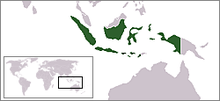
The environment of Indonesia consists of 17,508 islands scattered over both sides of the equator. [1] [2] Indonesia's size, tropical climate, and archipelagic geography, support the world's second highest level of biodiversity after Brazil. [3]

The environment of Indonesia consists of 17,508 islands scattered over both sides of the equator. [1] [2] Indonesia's size, tropical climate, and archipelagic geography, support the world's second highest level of biodiversity after Brazil. [3]
Indonesia's large and growing population and rapid industrialisation present serious environmental issues, which are often given a lower priority due to high poverty levels and weak, under-resourced governance. [4] Issues include large-scale deforestation (much of it illegal) and related wildfires causing heavy smog over parts of western Indonesia, Malaysia and Singapore; over-exploitation of marine resources; and environmental problems associated with rapid urbanisation and economic development, including air pollution, traffic congestion, garbage management, and reliable water and waste water services. [4] Deforestation and the destruction of peatlands make Indonesia the world's third largest emitter of greenhouse gases. [5] Habitat destruction threatens the survival of indigenous and endemic species, including 140 species of mammals identified by the World Conservation Union (IUCN) as threatened, and 15 identified as critically endangered, including the Sumatran Orangutan. [6]
Indonesia has a below average but slightly improving performance in the global Environmental Performance Index (EPI) with an overall ranking of 107 out of 180 countries in 2016. This is also below average in the Asia Pacific region, behind Thailand but slightly ahead of China. The EPI was established in 2001 by the World Economic Forum as a global gauge to measure how well individual countries perform in implementing the United Nations' Sustainable Development Goals. The environmental areas where Indonesia performs worst (ie. highest ranking) are water resource management (128), environmental effects of fisheries (127) and forest management (109), followed closely by sanitation. Waste water treatment plans are expected to improve conditions a bit in the future. Indonesia performs best (ie. lowest ranking) in the area of climate and energy (41), mostly due to the excellent access to electricity, less so for CO2 emission levels from power production. Health impacts of environmental issues (78) and biodiversity and habitat (83) also ranks above average. [7] [8]
Indonesia is at serious risk from the projected effects of climate change. If emissions go unreduced, it is predicted that it will see an average temperature rise of around 1°C by the middle of the century, [9] 0.3°C per decade. [10] This amounts to almost double the frequency of extremely hot days (with temperatures above 35 °C (95 °F)) per year by 2030, a figure which is predicted to rise to nearly one in three days by the end of the century. [9] Rising temperatures risk increasing the frequency and severity of draught and food shortages, as it will have (and already has already had) a serious impact on precipitation and the patterns of wet and dry seasons upon which the Indonesian agricultural system is based. [10] It will also encourage diseases, such as dengue fever and malaria, and increases in wild-fires, which threaten the huge areas of rainforest in the country. [10]
Climate change is having and will have further serious impact in the form of rising sea levels. As Indonesia is the world’s largest archipelago state, at current rates, rising sea levels will result in 42 million Indonesian households over 2000 islands being at risk of submersion by the middle of this century. [11] Over 60% of Indonesia’s population live in low-lying coastal areas, including Jakarta, which is particularly at risk, as 40% of the city is below sea-level and is rapidly subsiding, putting a huge number of people at risk of displacement. [10] [12] [13]
All of this is likely to affect poorer communities the most. Over 50% of the population of Indonesia live on less than US$2 per day, and the poor will bear the brunt of the disastrous effects of climate change, including death, illness and displacement, “as they are typically the most vulnerable to the impacts of drought, floods, and landslides and pursue livelihoods that are highly dependent on climate-sensitive sectors (i.e fisheries and forestry)” [14]

Deforestation in Indonesia involves the long-term loss of forests and foliage across much of the country; it has had massive environmental and social impacts. Indonesia is home to some of the most biologically diverse forests in the world and ranks third in number of species behind Brazil and the Democratic Republic of Congo. [15]
As late as 1900, Indonesia was still a densely forested country: forests represented 84 percent of the total land area. Deforestation intensified in the 1970s [15] and has accelerated further since then. The estimated forest cover of 170 million hectares around 1900 decreased to less than 100 million hectares by the end of the 20th century. [16] In 2008, it was estimated that tropical rainforests in Indonesia would be logged out in a decade. [17] Of the total logging in Indonesia, up to 80% is reported to be performed illegally. [18]
Large areas of forest in Indonesia have been cleared by large multinational pulp companies, such as Asia Pulp and Paper, [19] and replaced by plantations. Forests are often burned by farmers [20] and plantation owners. Another major source of deforestation is the logging industry, driven by demand from China and Japan. [21] Agricultural development and transmigration programs moved large populations into rainforest areas, further increasing deforestation rates. The widespread deforestation (and other environmental destruction) in Indonesia is often described by academics as an ecocide. [22] [23] [24] [25] [26]
Logging and the burning of forests to clear land for cultivation has made Indonesia the world's third largest emitter of greenhouse gases, behind China and the United States. [27] Forest fires often destroy high capacity carbon sinks, including old-growth rainforest and peatlands. In May 2011, Indonesia declared a moratorium on new logging contracts to help combat this. [28] This appeared to be ineffective in the short-term, as the rate of deforestation continued to increase. By 2012 Indonesia had surpassed the rate of deforestation in Brazil, [29] and become the fastest forest clearing nation in the world. [30]Indonesia is a signatory to a number of treaties and international agreements:
| | This section needs expansion. You can help by adding to it. (December 2016) |
In 2020 the rate of deforestation in Indonesia was the slowest since 1990. It was 75% lower than in 2019. This is because the government stopped issuing new licences to cut forests, including for palm oil plantations. The falling price of palm oil facilitated making it. Very wet weather reduced wildfires what also contributed to the achievement. [31]

Deforestation or forest clearance is the removal and destruction of a forest or stand of trees from land that is then converted to non-forest use. Deforestation can involve conversion of forest land to farms, ranches, or urban use. About 31% of Earth's land surface is covered by forests at present. This is one-third less than the forest cover before the expansion of agriculture, with half of that loss occurring in the last century. Between 15 million to 18 million hectares of forest, an area the size of Bangladesh, are destroyed every year. On average 2,400 trees are cut down each minute. Estimates vary widely as to the extent of deforestation in the tropics. In 2019, nearly a third of the overall tree cover loss, or 3.8 million hectares, occurred within humid tropical primary forests. These are areas of mature rainforest that are especially important for biodiversity and carbon storage.

Illegal logging is the harvest, transportation, purchase, or sale of timber in violation of laws. The harvesting procedure itself may be illegal, including using corrupt means to gain access to forests; extraction without permission, or from a protected area; the cutting down of protected species; or the extraction of timber in excess of agreed limits. Illegal logging is a driving force for a number of environmental issues such as deforestation, soil erosion and biodiversity loss which can drive larger-scale environmental crises such as climate change and other forms of environmental degradation.
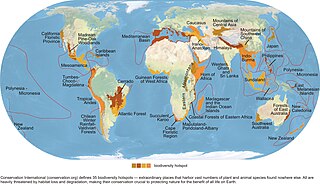
Habitat destruction occurs when a natural habitat is no longer able to support its native species. The organisms once living there have either moved to elsewhere or are dead, leading to a decrease in biodiversity and species numbers. Habitat destruction is in fact the leading cause of biodiversity loss and species extinction worldwide.
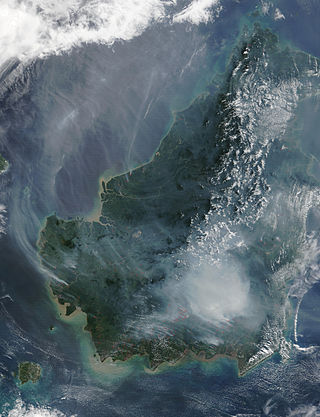
Peat swamp forests are tropical moist forests where waterlogged soil prevents dead leaves and wood from fully decomposing. Over time, this creates a thick layer of acidic peat. Large areas of these forests are being logged at high rates.
Environmental issues in Bolivia include deforestation caused by commercial agriculture, urbanization, and illegal logging, and biodiversity loss attributed to illegal wildlife trade, climate change, deforestation, and habitat destruction. Since 1990, Bolivia has experienced rapid urbanization raising concerns about air quality and water pollution.
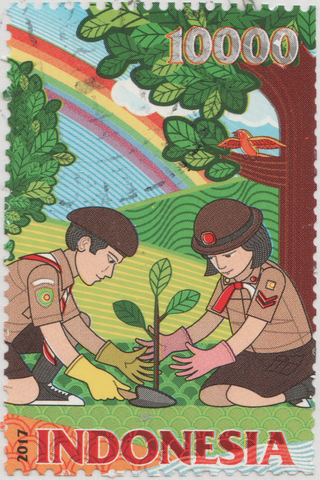
Environmental issues in Indonesia are associated with the country's high population density and rapid industrialisation, and they are often given a lower priority due to high poverty levels, and an under-resourced governance.

The Borneo peat swamp forests ecoregion, within the tropical and subtropical moist broadleaf forests biome, are on the island of Borneo, which is divided between Brunei, Indonesia and Malaysia.

The flora consists of many unique varieties of tropical plants. Blessed with a tropical climate and roughly 17,000 islands, Indonesia is the nation with the second highest biodiversity in the world. The flora of Indonesia reflects an intermingling of Asian, Australian and unique, Indonesian lineages. This is due to the geography of Indonesia, located between the aforementioned continents. The archipelago consists of a variety of regions, from the tropical rain forests of the northern lowlands and the seasonal forests of the southern lowlands through the hill and mountain vegetation, to subalpine shrub vegetation. With the second longest coastline in the world, Indonesia also has many swamps and other varieties of coastal vegetation. Combined, these all give rise to a huge floral biodiversity. There are about 28,000 species of flowering plants documented in Indonesia, including 2500 orchids, 122 species of bamboo, over 350 species of rattan and 400 species of Dipterocarpus, including ebony, sandalwood and teakwood. Indonesia is also home to some unusual species of carnivorous plants. One exceptional species is known as Rafflesia arnoldi, named after Sir Thomas Stamford Raffles and Dr. Thomas Arnold, who discovered the flower in the depths of Bengkulu, southwest Sumatra. This parasitic plant has the largest flower of any plant, does not produce leaves and grows only on one species of liana on the rainforest floor. Another unusual plant is Amorphophallus titanum from Sumatra. Numerous species of insect trapping pitcher plants can also be found in Borneo, Sumatra, and other islands of the Indonesian archipelago. There are a staggering 6000 traditional medicinal plants used as Jamu.,

Brazil once had the highest deforestation rate in the world and in 2005 still had the largest area of forest removed annually. Since 1970, over 700,000 square kilometres (270,000 sq mi) of the Amazon rainforest have been destroyed. In 2001, the Amazon was approximately 5,400,000 square kilometres (2,100,000 sq mi), which is only 87% of the Amazon's original size. According to official data, about 729,000 km² have already been deforested in the Amazon biome, which corresponds to 17% of the total. 300,000 km² have been deforested in the last 20 years.

Fern is a Dutch foundation created in 1995. It is an international Non-Governmental Organization (NGO) set up to keep track of the European Union's (EU) involvement in forests and coordinate NGO activities at the European level. Fern works to protect forests and the rights of people who depend on them.
Environmental issues in Brazil include deforestation, illegal wildlife trade, illegal poaching, air, land degradation, and water pollution caused by mining activities, wetland degradation, pesticide use and severe oil spills, among others. As the home to approximately 13% of all known species, Brazil has one of the most diverse collections of flora and fauna on the planet. Impacts from agriculture and industrialization in the country threaten this biodiversity.
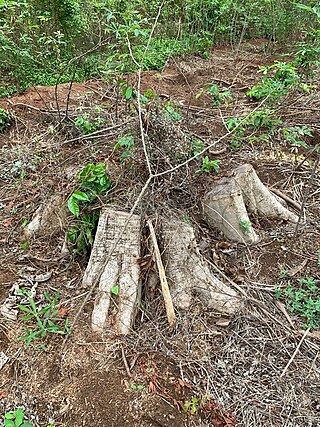
Deforestation in Nigeria refers to the extensive and rapid clearing of forests within the borders of Nigeria. This environmental issue has significant impacts on both local and global scales.

The Amazon rainforest, spanning an area of 3,000,000 km2, is the world's largest rainforest. It encompasses the largest and most biodiverse tropical rainforest on the planet, representing over half of all rainforests. The Amazon region includes the territories of nine nations, with Brazil containing the majority (60%), followed by Peru (13%), Colombia (10%), and smaller portions in Venezuela, Ecuador, Bolivia, Guyana, Suriname, and French Guiana.

Rates and causes of deforestation vary from region to region around the world. In 2009, two-thirds of the world's forests were located in just 10 countries: Russia, Brazil, Canada, the United States, China, Australia, the Democratic Republic of the Congo, Indonesia, India, and Peru.

Palm oil, produced from the oil palm, is a basic source of income for many farmers in South East Asia, Central and West Africa, and Central America. It is locally used as cooking oil, exported for use in much commercial food and personal care products and is converted into biofuel. It produces up to 10 times more oil per unit area than soybeans, rapeseed or sunflowers.

Deforestation in Indonesia involves the long-term loss of forests and foliage across much of the country; it has had massive environmental and social impacts. Indonesia is home to some of the most biologically diverse forests in the world and ranks third in number of species behind Brazil and the Democratic Republic of Congo.

Deforestation in Borneo has taken place on an industrial scale since the 1960s. Borneo, the third largest island in the world, divided between Indonesia, Malaysia and Brunei, was once covered by dense tropical and subtropical rainforests.

Central American countries have experienced cycles of deforestation and reforestation since the decline of Maya civilization, influenced by many factors such as population growth, agriculture, narcotic distribution and illegal practices. From 2001 to 2010, 5,376 square kilometres (2,076 sq mi) of forest were lost in the region. In 2010 Belize had 63% of remaining forest cover, Costa Rica 46%, Panama 45%, Honduras 41%, Guatemala 37%, Nicaragua 29%, and El Salvador 21%. Most of the loss occurred in the moist forest biome, with 12,201 square kilometers. Woody vegetation loss was partially set off by a plus in the coniferous forest biome with 4,730 km2, and at 2,054 km2. Mangroves and deserts contributed only 1% to the loss in forest vegetation. The bulk of the deforestation was located at the Caribbean slopes of Nicaragua with a minus of 8,574 square kilometers of forest lost in the period from 2001 to 2010. The most significant regrowth of 3,050 km2 of forest was seen in the coniferous woody vegetation of Honduras.
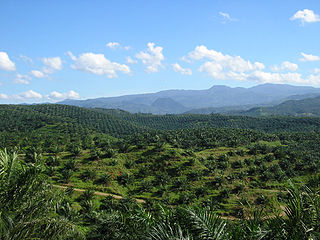
Palm oil production is important to the economy of Indonesia as the country is the world's biggest producer and consumer of the commodity, providing about half of the world's supply. In 2016, Indonesia produced over 34.6 million metric tons of palm oil, and exported 25.1 million metric tons of it. Oil palm plantations stretch across at least 12 million hectares. There are several different types of plantations, including small, privately owned plantations, and larger, state-owned plantations. There are a variety of health, environmental, and societal impacts that result from the production of palm oil in Indonesia. A recent publication by the NGO Rainforest Action Network (RAN) indicates that the use of palm oil by some of the biggest chocolate and snacks' producers is increasing this problem.

Due to its geographical and natural diversity, Indonesia is one of the countries most susceptible to the impacts of climate change. This is supported by the fact that Jakarta has been listed as the world's most vulnerable city, regarding climate change. It is also a major contributor as of the countries that has contributed most to greenhouse gas emissions due to its high rate of deforestation and reliance on coal power.
{{cite journal}}: Cite journal requires |journal= (help)